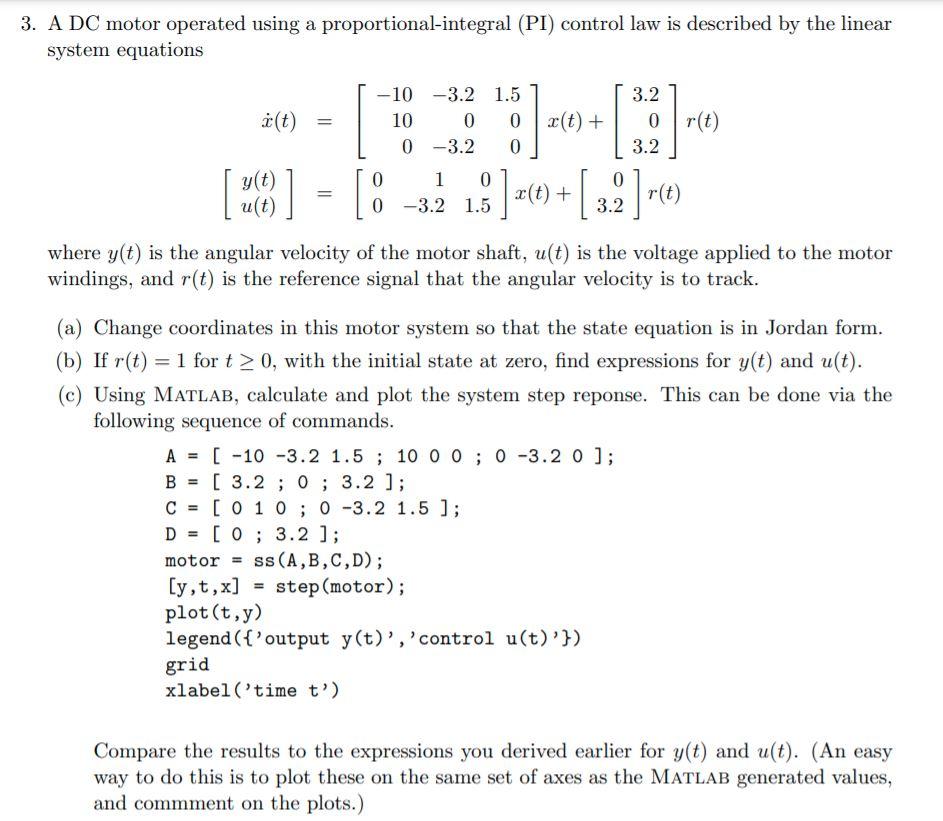
3. A DC motor operated using a proportional-integral (PI) control law is described by the linear system equations 3.2 i(t) -10 -3.2 1.5 10 0 0 x(t) + 0 -3.2 0 o r(t) 3.2 915 1.5 ]-(e)+[ 3.9]" y(t) [CO] - 1 [ 0 1 0 0 -3.2 1.5 r(t) where y(t) is the angular velocity of the motor shaft, u(t) is the voltage applied to the motor windings, and r(t) is the reference signal that the angular velocity is to track. (a) Change coordinates in this motor system so that the state equation is in Jordan form. (b) If r(t) = 1 for t > 0, with the initial state at zero, find expressions for y(t) and u(t). (c) Using MATLAB, calculate and plot the system step reponse. This can be done via the following sequence of commands. A = [ -10 -3.2 1.5 ; 10 0 0;0 -3.2 0 ]; B [ 3.2 ; 0; 3.2 ]; C = [ 010; 0 -3.2 1.5 ]; D = [0; 3.2 ]; motor = ss(A,B,C,D); [y,t,x] = step(motor); plot(t,y) legend({'output y(t)', 'control u(t)'}) grid xlabel('time t') Compare the results to the expressions you derived earlier for y(t) and u(t). (An easy way to do this is to plot these on the same set of axes as the MATLAB generated values, and commment on the plots.) 3. A DC motor operated using a proportional-integral (PI) control law is described by the linear system equations 3.2 i(t) -10 -3.2 1.5 10 0 0 x(t) + 0 -3.2 0 o r(t) 3.2 915 1.5 ]-(e)+[ 3.9]" y(t) [CO] - 1 [ 0 1 0 0 -3.2 1.5 r(t) where y(t) is the angular velocity of the motor shaft, u(t) is the voltage applied to the motor windings, and r(t) is the reference signal that the angular velocity is to track. (a) Change coordinates in this motor system so that the state equation is in Jordan form. (b) If r(t) = 1 for t > 0, with the initial state at zero, find expressions for y(t) and u(t). (c) Using MATLAB, calculate and plot the system step reponse. This can be done via the following sequence of commands. A = [ -10 -3.2 1.5 ; 10 0 0;0 -3.2 0 ]; B [ 3.2 ; 0; 3.2 ]; C = [ 010; 0 -3.2 1.5 ]; D = [0; 3.2 ]; motor = ss(A,B,C,D); [y,t,x] = step(motor); plot(t,y) legend({'output y(t)', 'control u(t)'}) grid xlabel('time t') Compare the results to the expressions you derived earlier for y(t) and u(t). (An easy way to do this is to plot these on the same set of axes as the MATLAB generated values, and commment on the plots.)







